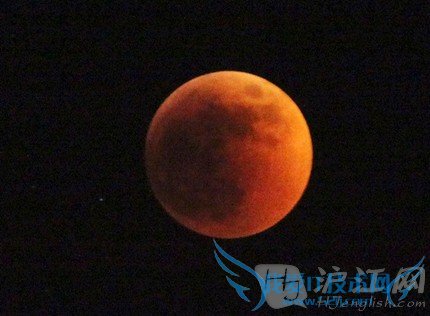��ӭ������52ijӢ��������������С��Ϊ�������Ӣ��֪ʶ�ǣ�������ʳ���ա�Ϥ������̨���ء�Ѫ��������Ե�ɡ�����������ϸ�ķ�����
����ʳ���ա�Ϥ������̨���ء�Ѫ��������Ե��

����ͼΪ�������ǹ۲����ȫʳ���ۣ�
SYDNEY �C Asian and African night owls were treated to a lunar eclipse, and ash in the atmosphere from a Chilean volcano turned it blood red for some viewers.Ϥ�ᡪ�����ͷ���ҹè���ǽ����賿���ҿ�����ʳ��׳�۾�������������ɽ�Ļ�ɽ�ҽ������������Ѫ��ɫ��
The Sydney Observatory said the eclipse was to begin at 3:25 a.m. Thursday (1:25 p.m. EDT, 5:25 p.m. GMT Wednesday) and last until after 5 a.m.Ϥ������̨�Ʊ�����ʳ��ʼ���賿3��25�֣����������賿5�㣨�����ļ�ʱ��1:25p.m. �������α�ʱ��������5:25p.m.����
Scientists said the specific phenomenon happening on Thursday �� known as a "deep lunar eclipse" �� often exudes a coppery color. But the intensity of the color depends on the amount of ash and dust in the atmosphere.��ѧ�ҽ���˵�����۷����������ģ���ȫʳ����ͨ�����ֳ�ͭɫ����������ɫ����dzȡ���ڿ����������Ļҽ��ͳ�����������
Luckily for moon-gazers, there was plenty of ash in the air so the moon appeared orange or red, especially in Asia. Air travelers haven't been so lucky: The ash has grounded hundreds of flights around the region.���˵��DZ�����ȫʳ�����У������к��д����ij������������������Ĺ۲������ҿ������������ɫ�ͺ�ɫ�������ÿ���û����ô�����ˣ���������ʹ����һ����ļ��ٸ���������
Scientists said the eclipse could be safely observed with the naked eye.��ѧ�ұ�ʾ������ʳ���۹۲��ǰ�ȫ�ġ�
- �����б����������۽������ѱ�����˿���������������վͬ����۵��֤ʵ��������
-
